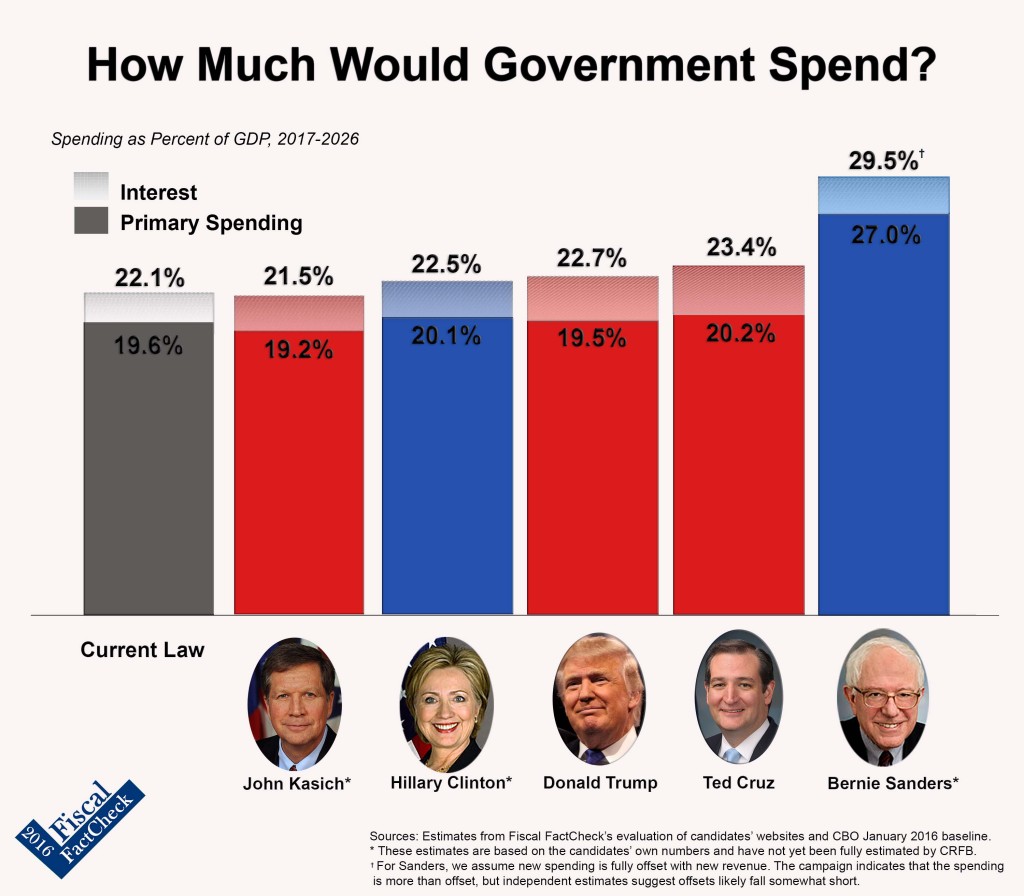How Much Will Government Spend Under the Next President?
One interesting metric of any budget plan is how much it would increase or reduce federal spending.
According to our latest estimates, all candidates but one – based on the policies they have released so far – would actually increase government spending above current law levels over the next decade. We hope two new Fiscal FactCheck infographics, released today, will provide an important compliment to our previous tax cut infographic.
To determine government spending for each of the five remaining presidential candidates, we relied on our previous analyses of the major fiscal plans of Sen. Ted Cruz (R-TX) and Donald Trump (and newer analysis of Mr. Trump’s health plan), as well as information made public by the Kasich, Clinton, and Sanders campaigns. In the case of Sec. Hillary Clinton and Sen. Bernie Sanders (I-VT), their campaign spending numbers are roughly in line with our preliminary findings; Gov. John Kasich (R-OH) has not provided sufficient detail to back up his claimed spending numbers. Our estimates are based on what is available so far, and of course they will change as new policies are released.
So how do the candidates stack up? As the infographic below shows, total spending (including interest) over the next decade will average 22.1 percent of Gross Domestic Product (GDP) under current law. Under Gov. Kasich it would average 21.5 percent, under Sec. Clinton 22.5, under Mr. Trump 22.7, under Sen. Cruz 23.4, and under Sen. Sanders 29.5 percent of GDP.

Share this graphic on Twitter.
Thinking about these levels relative to current law provides another way to visualize these figures. When interest is included, Gov. Kasich would shrink spending by 2 percent, Sec. Clinton would grow it by 2 percent, Mr. Trump would grow it by 3 percent, Sen. Cruz would grow it by 6 percent, and Sen. Sanders would grow spending by roughly one third – 33 percent.

Share this graphic on Twitter.
As the campaign continues, we will be releasing further analysis of their policies and continuing to update these figures to account for new policies and proposals.
Appendix: Source of Estimates for the Candidates’ Plans
Our spending estimates for Sen. Cruz and Mr. Trump are based on our previous analyses, broken up by spending and revenue and added to the Congressional Budget Office’s (CBO) January 2016 Baseline. For Sen. Cruz, figures come from our central central cost estimate of his plans. Estimates of Mr. Trump’s plans are based on our low-cost estimate of his plans (unadjusted for GDP changes) in combination with a more recent estimate of his health care plan. Though we did not develop a “central cost estimate” for Mr. Trump, his low-cost estimate excluding GDP is comparable on an apples-to-apples basis with Sen. Cruz’s central cost estimate – both rely on the Tax Policy Center’s estimates of their tax plan, both rely on low cost estimates for new spending, and neither incorporate potential economic growth effects which are not a part of conventional scoring. Importantly, Mr. Trump’s estimate does not include any potential savings from his Medicaid block-granting proposal, which is currently insufficient in detail for us to estimate.
To estimate spending for Gov. Kasich, we relied on his campaign’s proposed budget plan and assumed a similar change in spending would be applied to CBO’s latest baseline. Unfortunately, Gov. Kasich’s budget mostly consists of numbers and little detail to determine whether he supports sufficient policy changes to achieve these numbers (in the case of revenue, it is highly unlikely).
As with Gov. Kasich, our estimates for Sec. Clinton and Sen. Sanders are based on their campaigns’ own estimates rather than our independent analysis. However in both cases, our preliminary analysis suggests their campaign-provided estimates on spending (though not necessarily revenue) are plausible. Sec. Clinton has said that she plans to spend roughly $100 billion per year on her policy agenda, which is consistent with the policies she has released so far. Sen. Sanders, meanwhile, has listed the bulk of his spending agenda on his campaign website. Our preliminary analysis suggests that, on net, his estimates of new spending are plausible – with the possible exception of his health plan, which one independent estimate suggests could cost more than $1 trillion more per year. While we give Sen. Sanders the benefit of the doubt on his health plan, it is important to note that spending could be 5 percent of GDP or more higher if this independent analysis is correct. For both Sec. Clinton and Sen. Sanders, we assume their revenue is exactly equal to their spending based on their apparent commitment to fully pay for new initiatives, and as a result we assume no change in interest costs. Based on our preliminary analysis, this assumption appears to be true for Sec. Clinton. Sen. Sanders estimates his revenue will actually exceed spending, though independent estimates indicate it will likely fall short.

